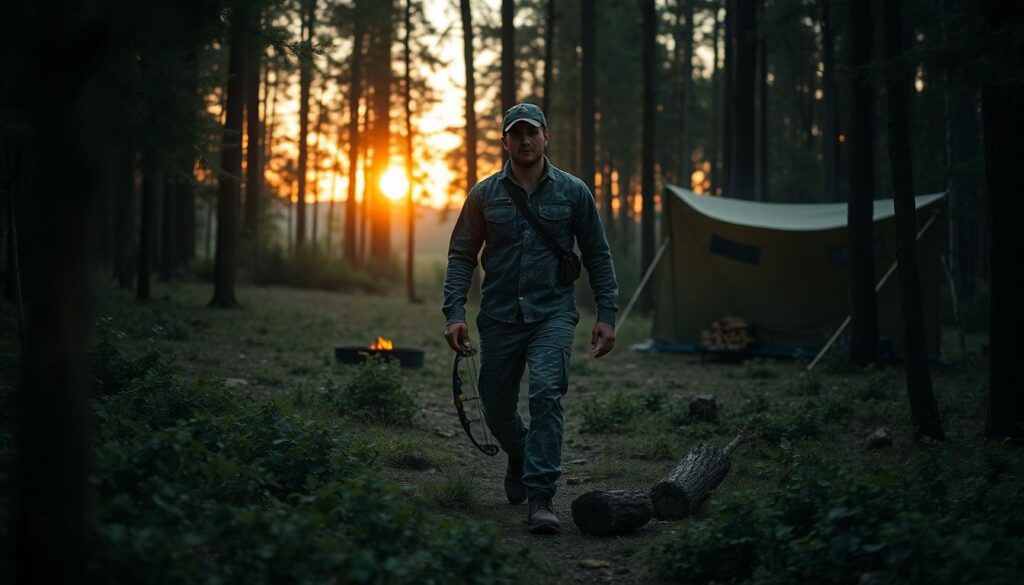Have you ever wondered how our ancient ancestors managed to thrive in the wilderness, relying solely on their wits and the land’s bounty for survival? Or perhaps you’re a prepper, eager to enhance your self-sufficiency skills, and you’ve asked yourself, ‘What if I found myself in a situation where I had to hunt for my own food?’ The art of survival hunting, also known as wilderness food sourcing or game procurement, is not just a fascinating historical topic, but a crucial skill set to master in today’s world. This article, ‘Survival Hunting: Essential Skills and Techniques for Preppers’, aims to equip you with the knowledge and techniques necessary to confidently and responsibly hunt for your own food in the wild.
First, let’s address the elephant in the room. Hunting, especially for survival purposes, can evoke a range of emotions, from excitement and empowerment to fear and uncertainty. But consider this: according to a study by the U.S. Fish and Wildlife Service, hunting contributes significantly to wildlife conservation, generating funds for habitat protection and restoration. Moreover, it’s a primal connection to our past, a skill that has kept our species alive for millennia. So, are you ready to tap into your inner caveman and learn how to provide for yourself in the wild?
Now, you might be thinking, ‘That sounds great, but I don’t know where to start.’ Fear not, dear reader, for that’s exactly why we’re here. In this comprehensive guide, we promise to demystify the art of survival hunting. We’ll delve into essential skills like tracking, trapping, and butchering, as well as ethical considerations and safety precautions. By the end of this article, you’ll not only have a solid understanding of how to procure game in the wilderness but also a newfound appreciation for the interconnectedness of all living things.
So, let’s embark on this journey together. Whether you’re a seasoned prepper or a curious beginner, there’s always more to learn about the art of survival hunting. Let’s roll up our sleeves, grab our gear, and dive into the fascinating world of wilderness food sourcing.
Mastering the Art of Survival Hunting: A Comprehensive Guide for Preppers
Embarking on the journey of mastering the art of survival hunting is akin to stepping into the shoes of our ancient ancestors, who relied on their wit, skill, and understanding of nature to thrive in the wild. In today’s world, where modern conveniences often shield us from the realities of survival, it’s crucial to cultivate these primal skills for when the unexpected occurs. This comprehensive guide, ‘Mastering the Art of Survival Hunting: A Comprehensive Guide for Preppers’, is your roadmap to self-sufficiency, ensuring you’re not just a spectator in the grand theater of life, but an active participant who can provide for oneself in any situation. From understanding your prey and their habitats, to mastering the art of tracking, stalking, and taking down game ethically and humanely, this guide delves into the intricacies of hunting with a respect for nature and its creatures. It’s not just about filling your belly; it’s about understanding the circle of life, the interconnectedness of all things, and our role as responsible stewards of the land. So, grab your pack, sharpen your knife, and let’s venture into the wild, where every lesson learned brings you one step closer to true self-reliance.
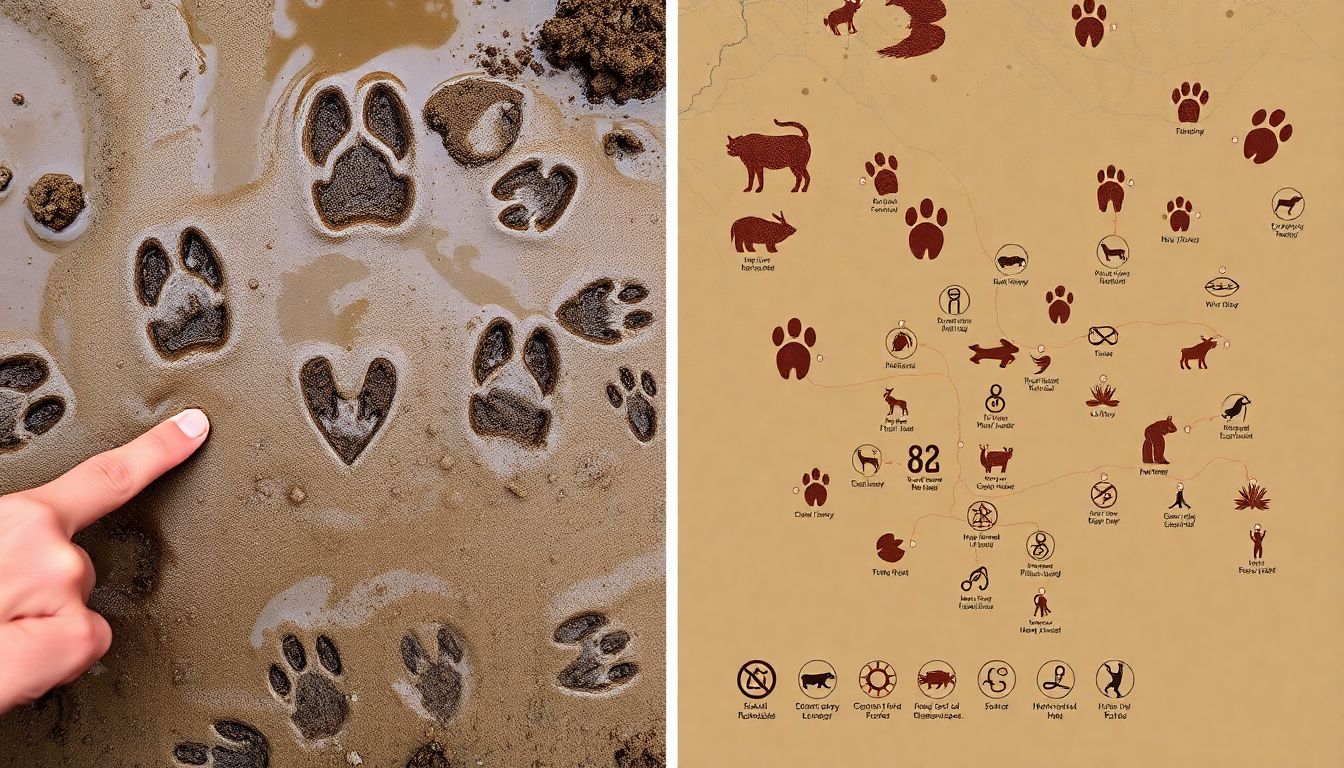
Understanding Your Surroundings: Essential Wilderness Awareness
In the vast, untamed wilderness, understanding your surroundings is not just an advantage, it’s a necessity. This is especially true for those who engage in survival hunting, where the difference between a successful hunt and a missed opportunity often lies in one’s ability to read the environment. The first step in this process is to become attuned to the subtle signs that nature provides.
Animal tracks, signs, and behaviors are like a language that, once learned, can reveal a wealth of information. Tracks in the mud or snow can tell you the size, species, and sometimes even the age and health of an animal. Signs like broken branches, disturbed leaves, or scat can indicate an animal’s recent presence. Behaviors, such as alarm calls or territorial displays, can warn you of nearby predators or alert you to the presence of prey. To read these signs effectively, you need to know your local fauna intimately, studying field guides and observing animals in their natural habitats.
The landscape, weather patterns, and time of day can also be powerful allies in survival hunting. Topography can dictate an animal’s movement, with steep slopes and dense cover often providing refuge. Weather can influence an animal’s behavior, with many species becoming more active during certain conditions. The time of day can also play a significant role, with dawn and dusk often being prime hunting times. Understanding these factors and how they interact can help you anticipate an animal’s movements and increase your chances of a successful hunt.
The concept of ‘pattern of life’ is central to understanding your surroundings. This refers to the predictable behaviors and routines that animals exhibit, driven by their needs for food, water, shelter, and reproduction. Observing and interpreting these patterns can provide valuable insights into an animal’s habits and help you anticipate its movements. For instance, a deer might consistently visit a watering hole at dusk, providing a reliable opportunity for a hunter.
To observe and interpret these patterns, you need to be patient, observant, and methodical. Spend time in an area, watching and recording the movements of animals. Look for consistent behaviors and routines. Consider the factors that might influence these patterns, such as the time of day, weather conditions, or the presence of other animals. Over time, you’ll begin to see the ‘pattern of life’ emerge, allowing you to anticipate an animal’s movements and increase your chances of a successful hunt. This understanding doesn’t just make you a better hunter, it also fosters a deeper connection with the natural world, turning you from a mere observer into a participant in the intricate dance of life in the wilderness.
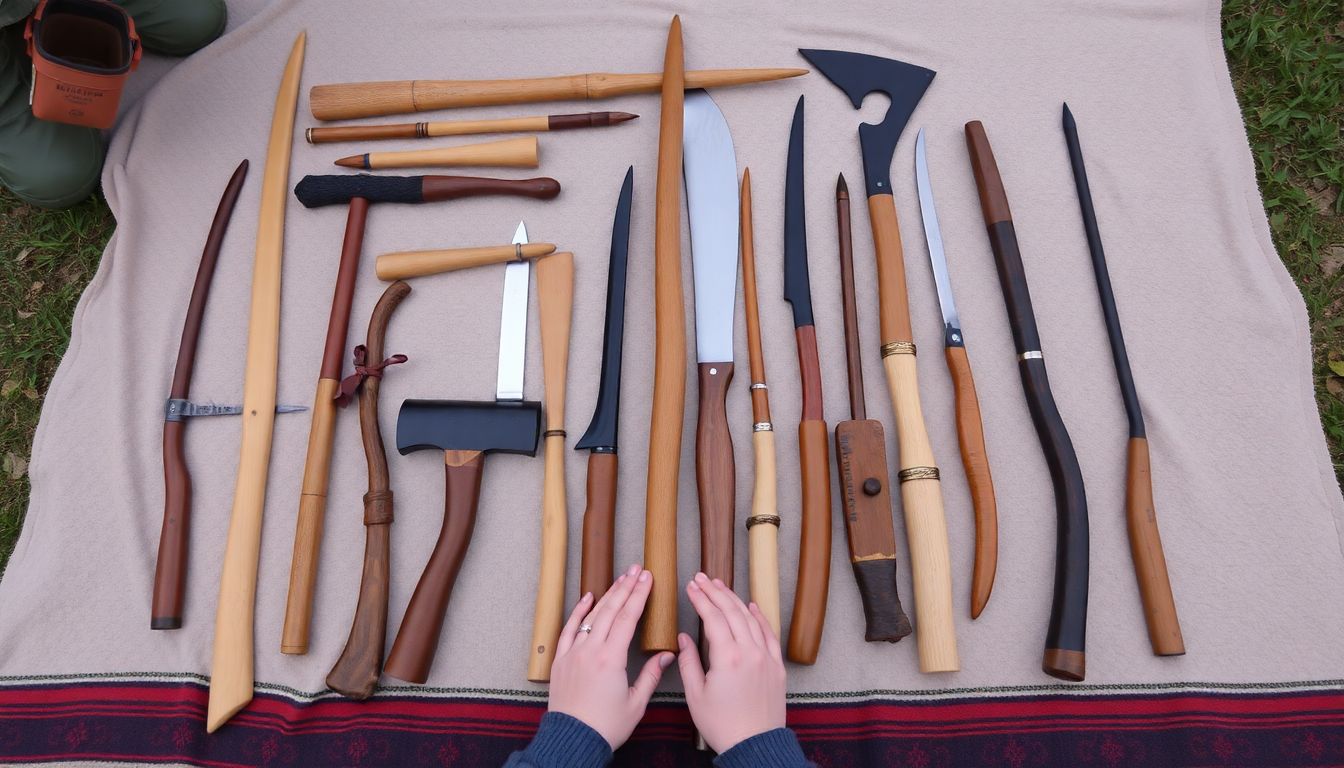
Choosing and Using Survival Hunting Weapons
Choosing and using survival hunting weapons is a critical skill for anyone venturing into the wilderness. The ideal weapon should be silent, stealthy, and reliable, as noise can scare off prey and alert other predators to your presence. Let’s delve into the pros and cons of three popular survival hunting weapons: bows, crossbows, and spears.
Bows are lightweight, versatile, and easy to carry, making them a top choice for many survivalists. They’re silent in operation, allowing for stealthy hunting. However, they require a certain level of skill to use effectively, and their range is limited compared to firearms. Maintaining a bow in the wilderness involves keeping it dry, as moisture can cause the string to fray or the wood to warp. Regularly waxing the string and storing it properly when not in use can extend its lifespan.
Crossbows offer several advantages over bows. They’re easier to use, as they can be loaded and aimed like a rifle, making them a good choice for beginners. They also have a longer range and can be more powerful, allowing for larger game to be taken. However, they’re heavier and bulkier than bows, making them less convenient to carry. They’re also louder than bows, which can be a disadvantage in stealth hunting. Maintaining a crossbow involves keeping it clean and lubricated, and storing it in a dry place to prevent rust.
Spears are simple, effective, and can be made from natural materials. They’re silent in use and can be thrown or used in close combat. However, they require close proximity to the prey, which can be dangerous. They’re also less effective against larger game. To maintain a spear, keep the shaft dry to prevent rot, and sharpen the point regularly using a stone or metal file.
If you find yourself without a weapon in the wilderness, don’t despair. Nature provides an abundance of materials that can be used to create simple hunting tools. Knives can be fashioned from sharp rocks or metal, while spears can be made from sturdy branches and sharpened stones. Bows can be crafted from flexible wood, and arrows from straight sticks and sharp stones. The key is to choose materials that are strong, durable, and well-suited to their intended purpose. Always remember to respect the environment and use only what you need.
In conclusion, the choice of survival hunting weapon depends on your skill level, the game you’re hunting, and the environment you’re in. Regardless of your choice, regular maintenance and care are crucial to ensure your weapon remains reliable and effective. And remember, the most important tool in survival hunting is not the weapon, but your knowledge, skill, and respect for the wilderness.
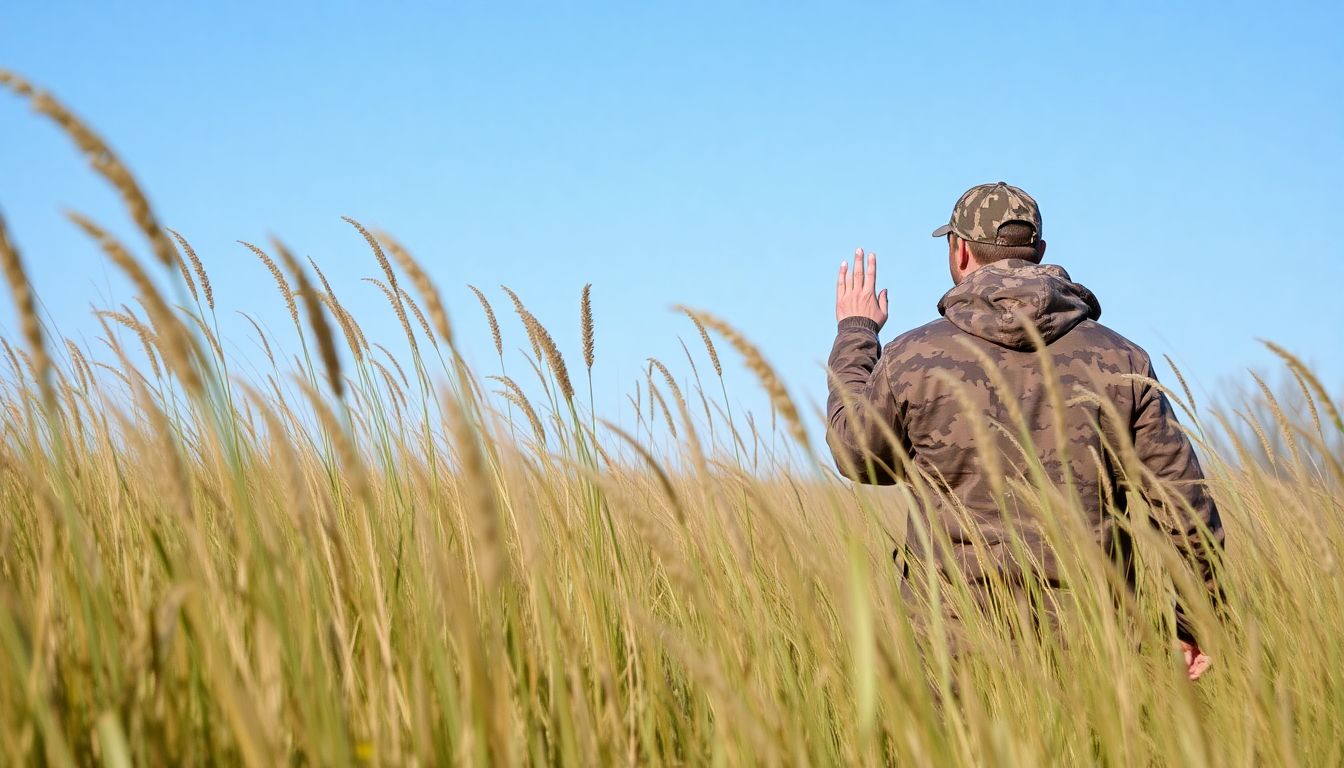
Stalking and Approaching Game: The Art of Stealth
In the grand theater of survival hunting, patience and stealth are not just virtues; they are the leading actors, the unsung heroes that separate a successful hunt from a mere wilderness stroll. Patience, like a seasoned angler waiting for the perfect catch, is the art of enduring the quiet, the stillness, the seemingly endless wait for the right moment. It’s about understanding that the wilderness operates on its own clock, not ours, and respecting that rhythm is key to any successful encounter.
Stealth, on the other hand, is the silent dance we perform with the wild. It’s about moving through the wilderness like a whisper, using every tool at our disposal to blend in, to become one with the landscape. This is where the art of stealth truly shines. It’s about understanding cover and concealment, using the natural world to hide our presence. Every shadow, every bush, every tree becomes a potential ally, a silent sentinel that helps us move undetected.
One of the most underrated aspects of stealth is the concept of ‘game trails’. These are the invisible highways of the wild, the paths that animals take as they move through their territory. Understanding and using these trails to our advantage can significantly increase our chances of a successful hunt. By moving along these trails, we’re speaking the language of the wild, using the same paths that the animals do, making our presence less intrusive and more natural.
Approaching game without spooking it is a delicate ballet, a test of our patience, stealth, and understanding of animal behavior. It’s about moving slowly, deliberately, using every bit of cover we can find. It’s about understanding wind direction, using it to our advantage, ensuring that our scent doesn’t carry to our quarry. It’s about being aware of our surroundings, every sound, every movement, every shift in the light. It’s about being present, fully engaged, every sense heightened, every muscle ready to react. It’s about respect, for the animal, for the hunt, for the wild. It’s about understanding that we are not the apex predator, but a guest in this ancient dance, a dance that has been happening since time immemorial, a dance that we are privileged to be a part of.
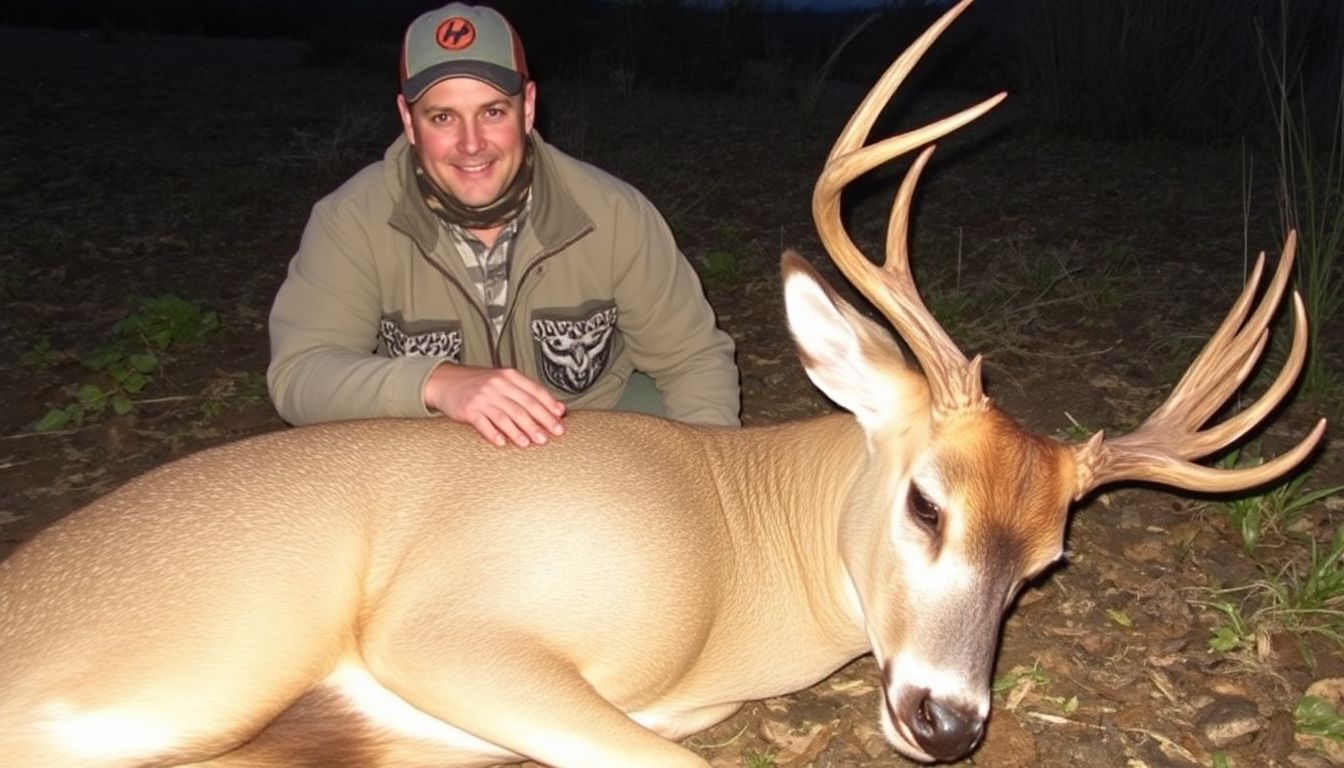
Ethical Hunting Practices: Respecting the Game and the Environment
In the realm of survival situations, ethical hunting practices are not just a moral obligation but a crucial aspect that ensures the sustainability of wildlife populations and the preservation of the environment. Ethical hunting is about more than just taking an animal for sustenance; it’s about respecting the game and the habitat it inhabits.
The concept of ‘fair chase’ is a cornerstone of ethical hunting. It’s not about the thrill of the kill, but the challenge and the respect for the animal’s life. Fair chase means giving the animal a fair opportunity to escape, using only the skills and tools at hand, no traps or bait. It’s about understanding the animal’s behavior and habitat, and engaging in a pursuit that is physically and mentally challenging for the hunter. This not only ensures a more humane hunt but also maintains the integrity of the hunting experience.
Once an animal has been taken, it’s essential to dispatch it humanely. This involves a quick, precise shot or a swift, decisive blow with a knife or blunt instrument. The goal is to render the animal unconscious immediately, followed by a swift death. This minimizes suffering and shows respect for the life that has been taken.
Leaving no trace is another critical aspect of ethical hunting. This means minimizing your impact on the environment. It’s about respecting the habitat as much as the game. This includes packing out all trash, not damaging vegetation, and being mindful of your movements to avoid disturbing wildlife. It’s about leaving the area as you found it, or better, for the sake of future generations and the ecosystem’s health.
In conclusion, ethical hunting practices are not just about the hunt, but about the responsibility we have towards the wildlife and the environment. It’s about respect, sustainability, and leaving a minimal footprint. It’s about understanding that we are part of an ecosystem, not apart from it.

Field Dressing and Butchering: Turning the Harvest into Food
Field dressing and butchering an animal is a critical step in transforming the harvest into nourishing meals. The importance of field dressing as soon as possible cannot be overstated. Time is of the essence here, as the animal’s body heat will quickly dissipate, and bacteria will begin to multiply, leading to spoilage and a loss of flavor. This is why it’s crucial to field dress the animal within minutes of the kill.
The process begins with making the initial cut. Using a sharp knife, make a deep incision from the animal’s breastbone to its pelvis, being careful not to puncture any organs. This allows the animal’s body heat to escape and cools the carcass rapidly. Next, reach inside the incision and locate the windpipe and esophagus. Cut these to prevent any fluids from leaking into the meat.
Now, it’s time to remove the organs. Carefully cut away the connective tissue holding them in place. The heart, liver, and lungs can be removed as a single unit. The stomach and intestines should be removed next, taking care not to puncture them. These organs can be used for various dishes or discarded, depending on your preference and the animal’s diet.
Once the organs are removed, the carcass can be hung to age, or it can be butchered immediately. To butcher, first, remove the head by cutting through the neck bones. Then, separate the legs at the hip and shoulder joints. The carcass can now be quartered by cutting through the backbone.
To separate the meat from the bones, start by removing the hide. This can be done by making a cut along the animal’s backbone, then using a sharp knife to carefully separate the hide from the meat. Once the hide is removed, the meat can be cut into manageable pieces. The ribs, loins, and shoulders can be removed as large roasts. The legs can be separated into the round, rump, and shank.
Throughout this process, hygiene and cleanliness are paramount. Always use clean, sharp knives to prevent contamination. Keep your work area clean, and avoid cross-contamination between the carcass and the meat you’ve already butchered. By following these steps and maintaining a clean workspace, you’ll turn the harvest into food that’s not only nourishing but also delicious.
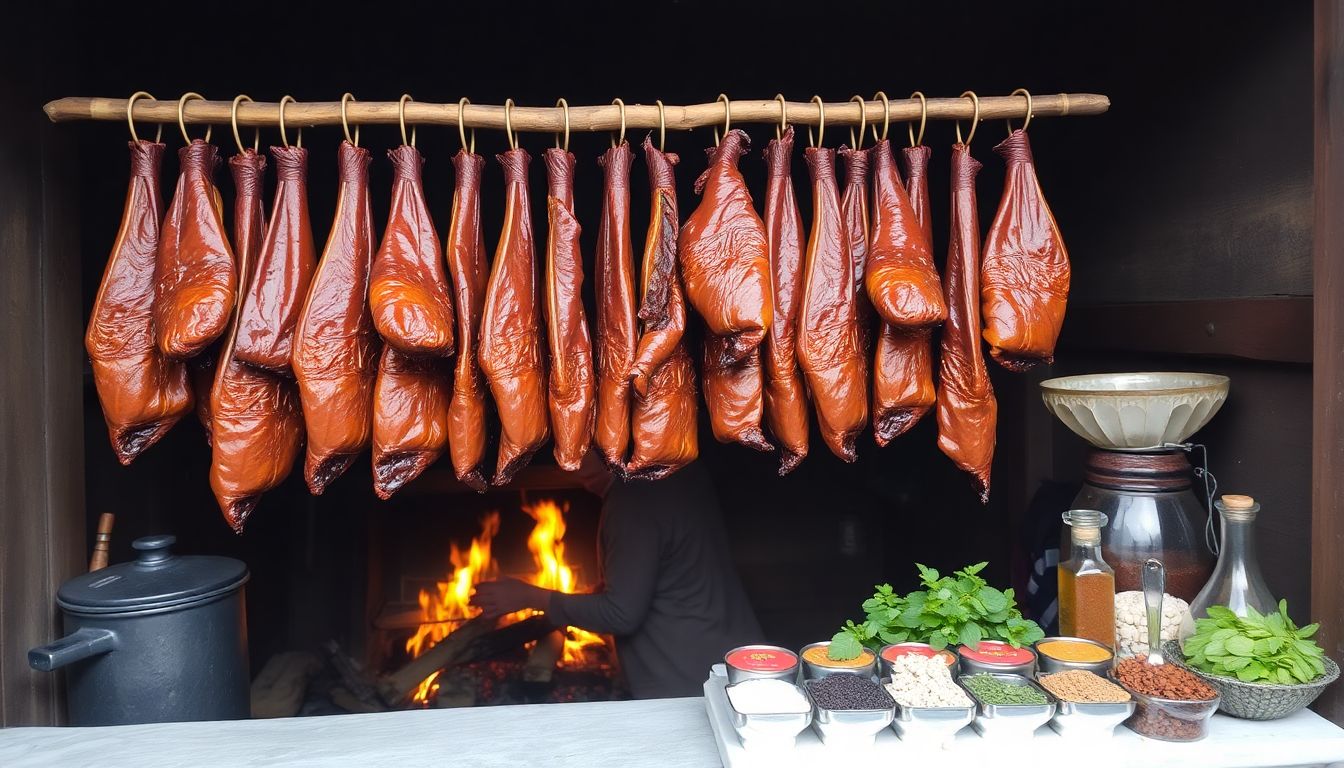
Preserving the Harvest: Curing, Smoking, and Drying Meat
In the vast expanse of human history, the ability to preserve food has been a cornerstone of survival and prosperity. Nowhere is this more apparent than in the preservation of meat, a vital source of protein and nutrients. In a survival situation, the knowledge and skills to preserve meat can mean the difference between sustenance and starvation. This is where techniques like curing, smoking, and drying come into play, each offering unique advantages and requiring specific equipment and materials.
The art of curing, for instance, involves the use of salt, nitrates, and sometimes sugar to draw out moisture and inhibit bacterial growth. This method is particularly effective for preserving meats like bacon, ham, and salami. The process begins with a thorough rubbing of the meat with a cure mixture, followed by a period of refrigeration to allow the salt to penetrate. The pros of curing include a long shelf life, enhanced flavor, and the prevention of harmful bacteria like botulinum. However, it requires careful monitoring to avoid over-salting, and the process can be time-consuming. The equipment needed is minimal, consisting mainly of a sharp knife, mixing bowls, and a refrigerator or cool, dry place to store the meat.
Smoking, another ancient method of preservation, involves exposing meat to the smoke of burning wood. This not only imparts a rich, smoky flavor but also creates a barrier that protects the meat from bacteria and mold. The process typically involves a smoker or a makeshift smoking chamber, a heat source, and wood chips or sawdust. The pros of smoking include a long shelf life, enhanced flavor, and the ability to preserve a wide variety of meats. However, it requires constant monitoring to maintain a consistent temperature and smoke level, and the process can be slow. Additionally, the equipment needed can be complex and expensive.
Drying, or jerky-making, is a simple and effective method of preserving meat that involves removing moisture through heat and air circulation. This method is particularly useful for lean meats like venison and turkey. The process begins with slicing the meat into thin strips, which are then marinated and hung to dry in a warm, dry place or in a dehydrator. The pros of drying include a long shelf life, portability, and the ability to preserve lean meats without the need for refrigeration. However, it requires a consistent heat source and can result in a tougher texture. The equipment needed is minimal, consisting mainly of a sharp knife, a dehydrator or a warm, dry place, and string or a rack to hang the meat.
Regardless of the method chosen, safe storage and transportation of preserved meat are paramount. This involves keeping the meat in a cool, dry place, away from direct sunlight and pests. For long-term storage, vacuum sealing or canning can be used to further extend the shelf life. In a survival situation, every morsel of food is precious, and the ability to preserve meat can mean the difference between life and death. Therefore, understanding and mastering these ancient techniques can be a valuable skill to have.
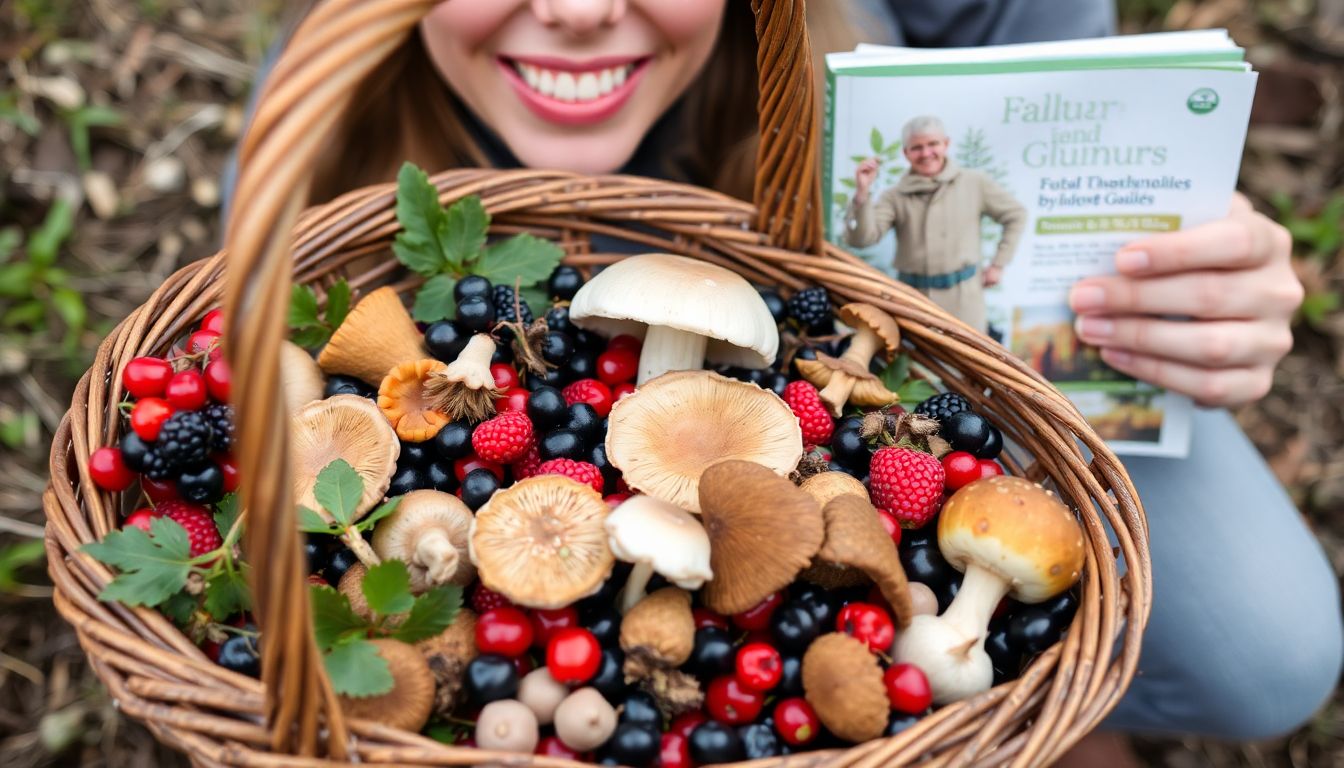
Foraging and Supplementing Your Diet: The Wilderness Pantry
In the grand pantry of nature, foraging and supplementing your diet with wild, edible plants, mushrooms, and other foods can be a lifesaving skill, especially in survival situations. This ancient practice not only provides essential nutrients but also connects us with the natural world. However, it’s crucial to approach foraging with caution and respect, as misidentification can have severe consequences.
The first step in safe foraging is education. Learn from reliable sources, such as experienced foragers, field guides, and online resources. Never rely solely on photos or apps for identification. Familiarize yourself with the plant’s entire life cycle, as appearances can change drastically from season to season.
When harvesting, follow these guidelines:
- Be 100% sure of your identification before consuming.
- Only take what you need, leaving plenty for the plant and other creatures.
- Avoid harvesting from areas with potential pollutants, such as roadsides or near industrial sites.
- Respect private property and obtain permission before foraging.
Once you’ve harvested your wild edibles, it’s time to prepare and cook them. Some plants can be eaten raw, while others require cooking to make them safe and palatable. Here are a few examples:
- Dandelion greens: Young leaves can be eaten raw in salads or cooked like spinach.
- Stinging nettle: Cooking neutralizes its stinging hairs, making it a delicious addition to soups and teas.
- Mushrooms: Many are delicious cooked in various dishes, but some are deadly. Always cook them thoroughly.
Preserving foraged foods extends their shelf life and allows you to enjoy them year-round. Techniques include drying, fermenting, pickling, and freezing. For instance, dried mushrooms can be stored for months, while fermented dandelion greens can last weeks in the fridge.
In conclusion, foraging and supplementing your diet with wild foods can be a rewarding and sustainable practice. It’s an opportunity to engage with nature, learn new skills, and ensure your survival in challenging situations. But remember, safety and respect are paramount in this wild pantry.
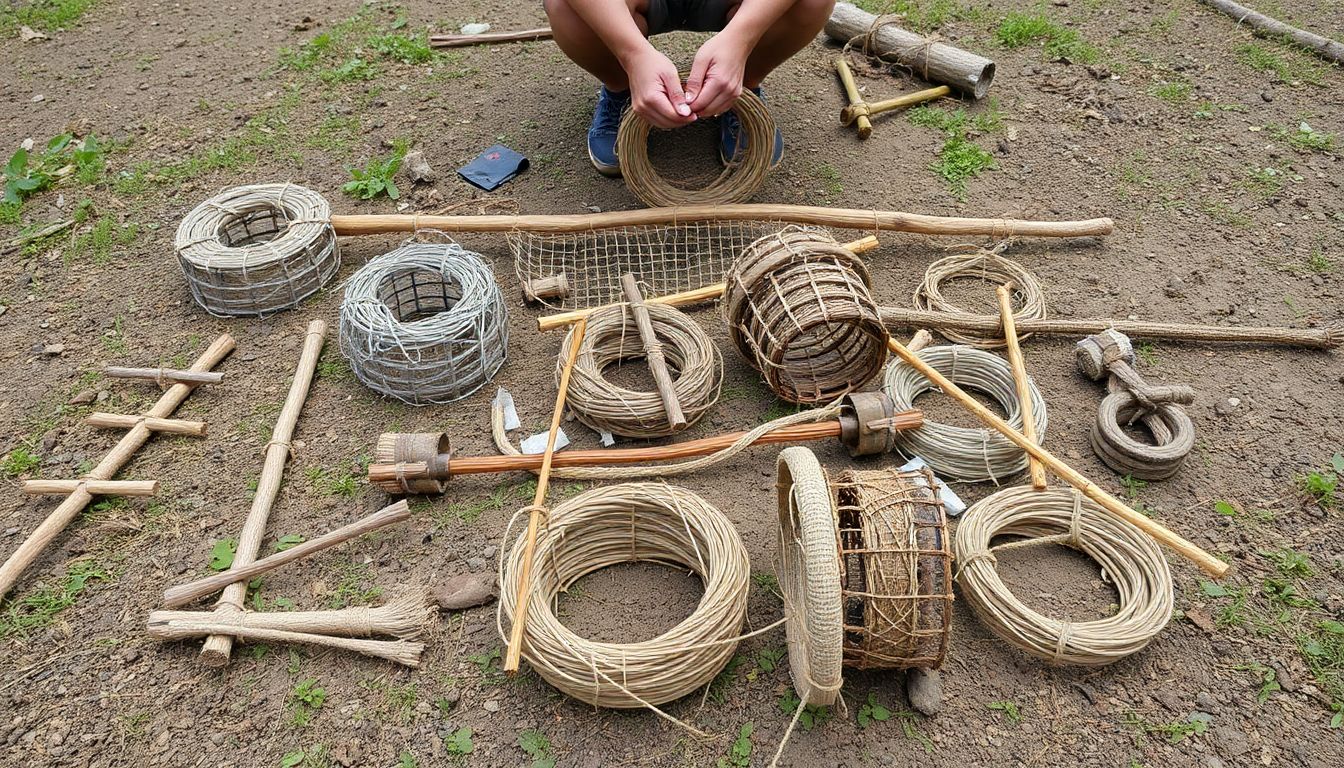
Setting Traps and Snares: Passive Game Procurement
In the crucible of survival, every calorie counts, and setting traps and snares becomes an invaluable skill for procuring game without depleting your precious energy reserves. This passive approach allows you to make the most of your surroundings, turning the wilderness into a cooperative partner in your quest for sustenance.
The art of trapping is as old as humanity itself, with a rich tapestry of techniques passed down through generations. At its core, trapping involves creating a mechanical advantage, using simple devices to overcome an animal’s natural defenses. Some of the most effective traps and snares can be crafted from natural materials found in your environment.
One such trap is the deadfall, a simple yet ingenious device that uses gravity to dispatch its prey. To create a deadfall, you’ll need a heavy rock or log, a sturdy stick, and a trigger mechanism made from a flexible sapling or vine. By placing the rock or log on the stick, with the trigger holding it in place, you create a trap that will snap shut when an unsuspecting animal disturbs the trigger.
Snares, on the other hand, are designed to capture animals by the neck or limb, allowing you to dispatch them humanely once they’re secured. A simple snare can be made from a length of vine or paracord, tied to a stake driven into the ground. The noose should be just large enough to allow the animal’s head to pass through, with a small stick or toggle inserted to keep it open until an animal triggers the trap.
When setting traps and snares, it’s crucial to consider the ethics of your actions. Always strive to dispatch an animal humanely, using a sharp knife or blow to the head to minimize suffering. Additionally, be mindful of the environment and the impact your traps may have on non-target species. By using baited traps sparingly and checking them regularly, you can minimize the risk of catching unintended prey.
In conclusion, setting traps and snares is a vital skill for any survivalist, allowing you to procure game without expending valuable energy. By understanding the different types of traps and snares, and how to craft them from natural materials, you can turn the wilderness into a bountiful larder. However, it’s essential to approach trapping with respect for the animals and the environment, ensuring that your actions are guided by compassion and a deep appreciation for the natural world.
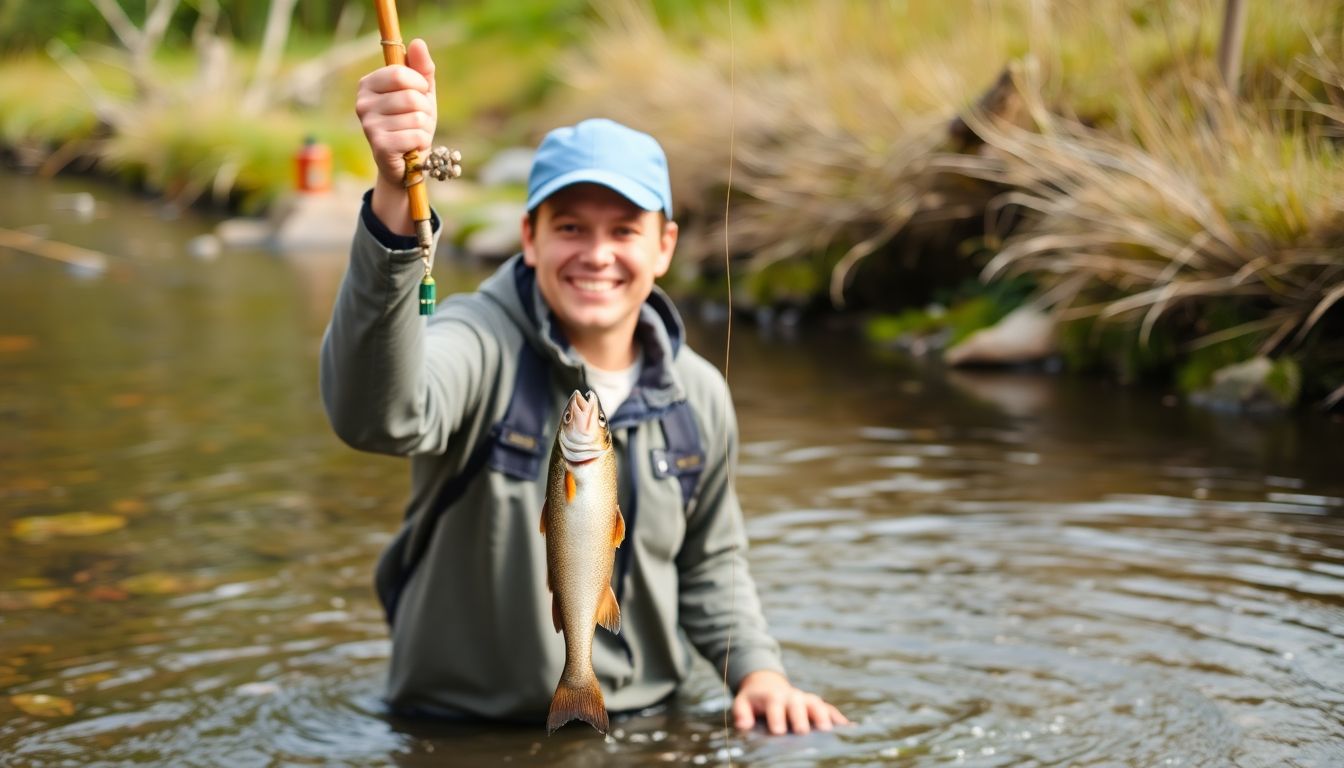
Fishing for Survival: A Viable Food Source
In a survival situation, securing a reliable food source is paramount. Fishing, an ancient and universal practice, becomes not just a pastime, but a lifeline. It’s a sustainable, high-protein option that requires minimal energy and resources to pursue. Here’s how you can make fishing work for you in various environments and seasons.
First, let’s discuss how to create simple fishing gear from natural materials. You’ll need a line, a hook, and perhaps a weight or float. A strong, flexible plant fiber like sinew or bark can serve as your line. For a hook, you can fashion one from a stiff, sharp piece of metal, or even a curved thorn. Weights can be made from stones, and floats from cork or hollow reeds.
Now, let’s explore different fishing techniques and strategies. Still fishing, where you anchor your line in one spot, is effective in calm waters. In moving water, try trotlining, where you suspend a line with multiple hooks across a current. For larger fish, spearfishing or using a fish trap made from woven branches can be successful. Adapt these techniques to your environment: use the edge of a river for still fishing, or cast your line from a high point for spearfishing.
Seasonal changes also dictate fishing strategies. In warmer months, fish are more active and feed near the surface. In colder months, they move deeper and slower, so you’ll need to adjust your casting depth and speed accordingly.
Once you’ve caught your fish, it’s time to prepare and cook it. Gut and scale the fish, then cook it whole or fillet it. Over an open fire, wrap it in leaves or place it on a stick and roast it. For preservation, smoking is an effective method. Build a smoker using green leaves or wood chips, and smoke the fish for several hours.
In conclusion, fishing is a versatile, sustainable, and high-yield food source in a survival situation. With a little creativity and knowledge, you can fashion gear, adapt techniques, and prepare your catch to maximize your chances of survival.

The Role of Furbearers in Survival Hunting
In the harsh, unforgiving world of survival hunting, every resource counts, and furbearers, small mammals with valuable pelts, play a pivotal role. These creatures, such as beavers, raccoons, and rabbits, are not just a source of protein but also provide essential materials for survival.
Hunting and trapping these animals require patience, stealth, and knowledge of their habits. Trapping is often more efficient, using devices like snares or deadfalls, set along their established trails. Hunting involves stalking or ambushing, using weapons like spears, bows, or even improvised clubs. Safety is paramount, as these animals can carry diseases like rabies.
Preparing the meat involves field dressing, removing the entrails, and skinning. The meat can be cooked over an open fire, roasted on a spit, or boiled in a makeshift pot. It’s lean, high in protein, and can be eaten fresh or preserved by smoking or drying.
The fur and hide are equally valuable. They can be used to make clothing, bedding, or even shoes, providing insulation and protection from the elements. The bones can be used for tools or utensils, while the sinew makes excellent cordage.
Ethics play a significant role in hunting and trapping furbearers. It’s crucial to understand their populations and hunting seasons to avoid overhunting. Only take what you need, and never waste an animal. Respect the creature’s life, and honor it by using every part. Always strive to minimize suffering, using humane trapping and dispatching methods. Lastly, leave no trace, removing all signs of your activity to preserve the ecosystem.
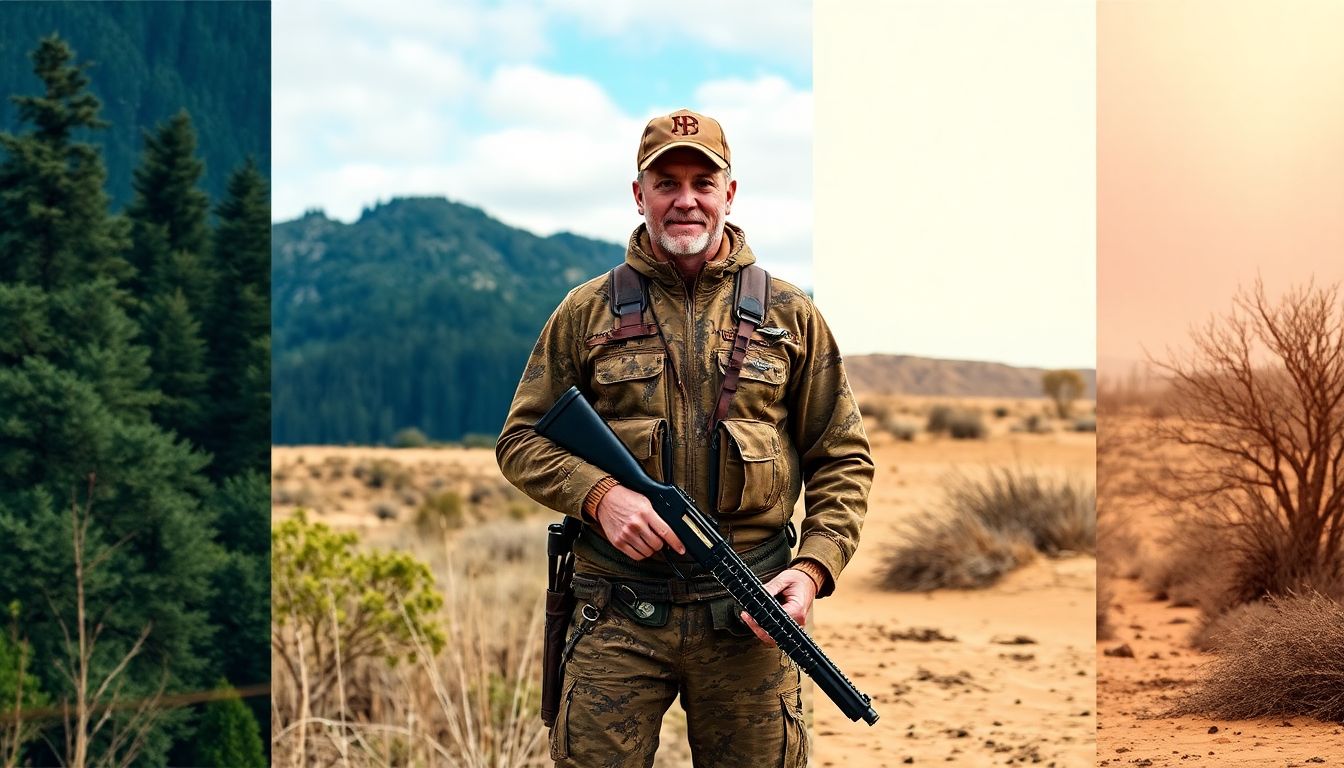
Survival Hunting in Different Environments: Adaptability is Key
Survival hunting in diverse environments is a testament to the human spirit’s adaptability. Each ecosystem, be it a dense forest, a barren desert, or a towering mountain range, presents unique challenges and opportunities. Adaptability, therefore, is not just an advantage but a necessity for the survival hunter.
The first step in adapting your hunting strategy is understanding the environment. Forests, with their dense canopies and abundant foliage, offer excellent cover for both hunter and prey. Here, stealth is key. Use the shadows to your advantage, move silently, and blend in with your surroundings. The forest floor is a treasure trove of edible plants and medicinal herbs, so knowing which ones to forage can supplement your diet and aid in healing.
Deserts, on the other hand, are harsh and unforgiving. The sun is your enemy, and water is your most precious commodity. Hunting during the cooler hours of the day is crucial. Look for animals that have adapted to the desert, like jackrabbits or roadrunners, which are active during the day. Oases and dry riverbeds can indicate water sources, but remember, so do animal tracks.
Mountains present their own set of challenges. The altitude can affect your body’s ability to regulate temperature, and the terrain can be treacherous. High-elevation animals like mountain goats and ibex are your targets here. They know the terrain better than you, so use their movements to guide you. The mountains also offer a wealth of edible plants, but be cautious, as some high-altitude plants can be toxic.
Water is the elixir of life in all environments. In forests, look for water sources along riverbanks or near large trees. Deserts have wadis (dry riverbeds) that can lead to underground water sources. In mountains, follow the waterlines
- the paths where water flows during rain. Always purify water before drinking to avoid waterborne diseases.
In conclusion, survival hunting is not just about tracking and killing prey. It’s about understanding and adapting to the environment. It’s about turning the unique features of each ecosystem into tools for your survival. It’s about respecting the land and its inhabitants, and using their strengths to overcome your weaknesses. After all, in the wild, adaptability is not just key, it’s the key to survival.
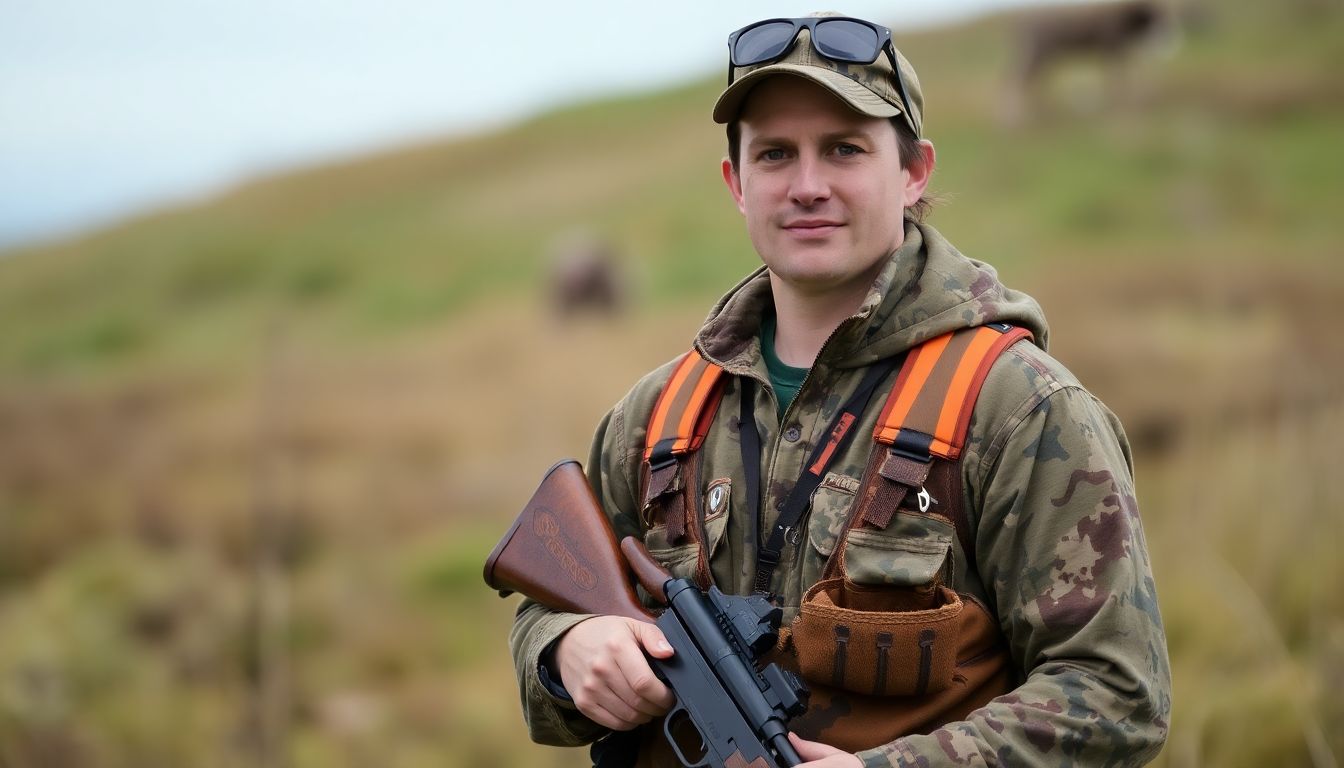
The Mental Game of Survival Hunting: Maintaining Composure and Focus
In the crucible of survival hunting, the mental game is as crucial as the physical. Maintaining a positive mental attitude is not just a nice-to-have, it’s a necessity. Fear and stress are inevitable companions in such situations, but they need not be crippling. The first step is to acknowledge and accept these feelings. They are your body’s way of preparing you for action, not signs of weakness. Instead of fighting them, channel them into focus and determination.
The art of managing stress and fear lies in breaking them down into manageable chunks. Instead of thinking ‘I have to survive for days in this wilderness’, reframe it as ‘What do I need to do in the next hour?’ This technique, known as ‘time boxing’, helps keep fear from overwhelming you.
Staying focused is about eliminating distractions and maintaining a clear mind. This is where a sense of humor and perspective come in. Humor can be a powerful tool in survival situations. It can help you see the absurdity in a difficult situation, lightening the mood and boosting morale. Perspective, on the other hand, helps you keep things in proportion. Remember, while your situation might be challenging, it’s not insurmountable.
Finally, let’s talk about ‘flow’. This is a state of complete absorption in what you do. It’s when you’re so focused on the task at hand that everything else fades away. To achieve flow in survival hunting, set clear goals, immerse yourself in the present moment, and maintain a sense of challenge. Remember, flow is not about being perfect, it’s about being completely engaged in the process. And that, in itself, can make even the toughest survival situation a little easier to bear.



